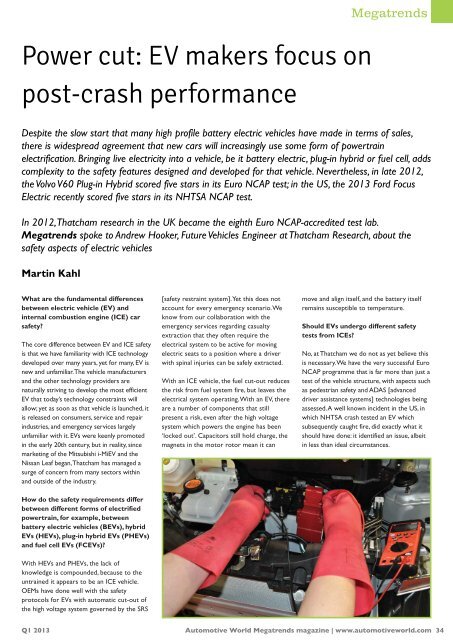megatrends
megatrends
megatrends
You also want an ePaper? Increase the reach of your titles
YUMPU automatically turns print PDFs into web optimized ePapers that Google loves.
Power cut: EV makers focus on<br />
post-crash performance<br />
What are the fundamental differences<br />
between electric vehicle (EV) and<br />
internal combustion engine (ICE) car<br />
safety?<br />
The core difference between EV and ICE safety<br />
is that we have familiarity with ICE technology<br />
developed over many years, yet for many, EV is<br />
new and unfamiliar. The vehicle manufacturers<br />
and the other technology providers are<br />
naturally striving to develop the most efficient<br />
EV that today’s technology constraints will<br />
allow; yet as soon as that vehicle is launched, it<br />
is released on consumers, service and repair<br />
industries, and emergency services largely<br />
unfamiliar with it. EVs were keenly promoted<br />
in the early 20th century, but in reality, since<br />
marketing of the Mitsubishi i-MiEV and the<br />
Nissan Leaf began, Thatcham has managed a<br />
surge of concern from many sectors within<br />
and outside of the industry.<br />
How do the safety requirements differ<br />
between different forms of electrified<br />
powertrain, for example, between<br />
battery electric vehicles (BEVs), hybrid<br />
EVs (HEVs), plug-in hybrid EVs (PHEVs)<br />
and fuel cell EVs (FCEVs)?<br />
With HEVs and PHEVs, the lack of<br />
knowledge is compounded, because to the<br />
untrained it appears to be an ICE vehicle.<br />
OEMs have done well with the safety<br />
protocols for EVs with automatic cut-out of<br />
the high voltage system governed by the SRS<br />
[safety restraint system]. Yet this does not<br />
account for every emergency scenario. We<br />
know from our collaboration with the<br />
emergency services regarding casualty<br />
extraction that they often require the<br />
electrical system to be active for moving<br />
electric seats to a position where a driver<br />
with spinal injuries can be safely extracted.<br />
With an ICE vehicle, the fuel cut-out reduces<br />
the risk from fuel system fire, but leaves the<br />
electrical system operating. With an EV, there<br />
are a number of components that still<br />
present a risk, even after the high voltage<br />
system which powers the engine has been<br />
‘locked out’. Capacitors still hold charge, the<br />
magnets in the motor rotor mean it can<br />
Megatrends<br />
Despite the slow start that many high profile battery electric vehicles have made in terms of sales,<br />
there is widespread agreement that new cars will increasingly use some form of powertrain<br />
electrification. Bringing live electricity into a vehicle, be it battery electric, plug-in hybrid or fuel cell, adds<br />
complexity to the safety features designed and developed for that vehicle. Nevertheless, in late 2012,<br />
the Volvo V60 Plug-in Hybrid scored five stars in its Euro NCAP test; in the US, the 2013 Ford Focus<br />
Electric recently scored five stars in its NHTSA NCAP test.<br />
In 2012, Thatcham research in the UK became the eighth Euro NCAP-accredited test lab.<br />
Megatrends spoke to Andrew Hooker, Future Vehicles Engineer at Thatcham Research, about the<br />
safety aspects of electric vehicles<br />
Martin Kahl<br />
move and align itself, and the battery itself<br />
remains susceptible to temperature.<br />
Should EVs undergo different safety<br />
tests from ICEs?<br />
No, at Thatcham we do not as yet believe this<br />
is necessary. We have the very successful Euro<br />
NCAP programme that is far more than just a<br />
test of the vehicle structure, with aspects such<br />
as pedestrian safety and ADAS [advanced<br />
driver assistance systems] technologies being<br />
assessed. A well known incident in the US, in<br />
which NHTSA crash tested an EV which<br />
subsequently caught fire, did exactly what it<br />
should have done: it identified an issue, albeit<br />
in less than ideal circumstances.<br />
Q1 2013 Automotive World Megatrends magazine | www.automotiveworld.com<br />
34


